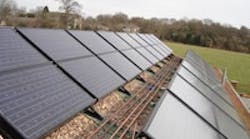Solimpeks Corp., a solar company based in Karatay, Turkey, has released the Volther hybrid solar collector, which is capable of producing electricity and hot water simultaneously.
The hybrid modules allow extra module heat to be absorbed to produce hot water, thus optimizing efficiency. Historically, the main drawback of many conventional photovoltaic systems has been the high initial cost as well as the limited amount of electrical output when compared to the solar input, the company explains. This Volther hybrid solar collector system allows excess heat to be recaptured.
The issue at hand are the two systems that currently capture energy from the sun. First is the solar collector that produces hot water out of the energy from the sun. Second there are PV (Photovoltaic) modules, which converts sunlight into electricity. Both systems utilize a black or dark surface that looks at the sun. This black surface absorbs the solar energy and heats up the solar collectors. However, when PV modules heat up their ability to generate electricity diminished at the rate of about 0.5% for every Kelvin. So a 10 degree rise in temperature in a PV module means a loss of about 5% of electricity output.
PV-T hybrid collectors have the following advantages:
- They have increased electricity production performance of the PV module.
- Hybrid PV-T systems cover areas where electricity and heat energy are produced from with half of this field using PV modules, the remaining half is thermal.
- Thermal collectors and PV modules to be installed side by side can create trouble in terms of availability and use and cause visual pollution. With PV-T modules, the electricity and hot water in the same area produce a space-saving and reduce environmental pollution.
Consequently, PV-T systems can reduce the temperature of PV cells resulting in an increased lifetime and efficiency. Calculations done by several scientists, organizations and universities indicate only 25 square meters of PV-T collectors are required for a normal family house in northern Europe to generate all their energy for an entire year.




